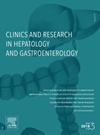在使用直接作用的抗病毒药物根除丙型肝炎后,尽管非侵入性纤维化标志物有所改善,但代谢因素导致肝脂肪变性早期增加
IF 2.4
4区 医学
Q2 GASTROENTEROLOGY & HEPATOLOGY
Clinics and research in hepatology and gastroenterology
Pub Date : 2025-06-16
DOI:10.1016/j.clinre.2025.102639
引用次数: 0
摘要
虽然直接作用抗病毒药物(DAAs)在丙型肝炎病毒(HCV)患者中获得了较高的持续病毒学反应(SVR)率,但它们对肝脂肪变性(HS)的影响尚不清楚。方法我们对来自麦吉尔大学和米兰大学的108例在DAAs后达到SVR的HCV患者进行了回顾性队列研究。采用控制衰减参数(CAP)和肝刚度测量(LSM)在基线和svr后24周评估HS和肝纤维化。HS定义为CAP≥248 dB/m, LSM≥8 kPa为显著肝纤维化,HS加≥1个心脏代谢危险因素为代谢功能障碍相关脂肪变性肝病(MASLD)。采用Wilcoxon sign -rank检验和标准化均差(SMD)评价变化。多变量logistic回归确定svr后HS的预测因子。结果svr后shs患病率由47%上升至61% (p = 0.0007, SMD = 0.30)。在基线HS患者中,88%有持续性脂肪变性。无基线HS的患者中有37%出现了新发脂肪变性,CAP显著增加(p <;0.0004、SMD = 0.48)。在没有基线HS的患者中,总胆固醇和甘油三酯升高(p = 0.0084, SDM = 0.43, p <;0.0001, SDM = 0.71),而基线HS组只有总胆固醇升高(p = 0.0296, SDM = 0.50)。在两个时间点,MASLD仍然是主要的病因(基线时为94%,svr后为92%)。显著纤维化从49%显著下降到17% (p <;0.0001, SMD = -0.80)。24周时较高的BMI与HS独立相关(校正优势比1.92,95% CI 1.22-3.03)。结论:尽管肝纤维化指标有所改善,但在DAAs治疗后,HS经常持续存在或出现,特别是伴随着以胆固醇和甘油三酯升高为特征的代谢功能障碍。本文章由计算机程序翻译,如有差异,请以英文原文为准。

Metabolic factors drive early increase in hepatic steatosis despite improvement in non-invasive fibrosis markers after hepatitis C eradication with direct-acting antivirals
Background
While direct-acting antivirals (DAAs) achieve high sustained virologic response (SVR) rates in people with hepatitis C virus (HCV), their impact on hepatic steatosis (HS) remains unclear.
Methods
We conducted a retrospective cohort study of 108 HCV patients from McGill University and the University of Milan who achieved SVR following DAAs. Controlled attenuation parameter (CAP) and liver stiffness measurement (LSM) were used to assess HS and liver fibrosis at baseline and 24 weeks post-SVR. HS was defined as CAP ≥248 dB/m, significant liver fibrosis as LSM ≥8 kPa, and metabolic dysfunction-associated steatotic liver disease (MASLD) as HS plus ≥1 cardiometabolic risk factors. Changes were evaluated using Wilcoxon signed-rank test and standardized mean difference (SMD). Multivariable logistic regression identified predictors of post-SVR HS.
Results
HS prevalence increased from 47 % to 61 % post-SVR (p = 0.0007, SMD = 0.30). Among patients with baseline HS, 88 % had persistent steatosis. New-onset steatosis developed in 37 % of patients without baseline HS, with a significant CAP increase (p < 0.0004, SMD=0.48). In patients without baseline HS, total cholesterol and triglycerides increased (p = 0.0084, SDM = 0.43 and p < 0.0001, SDM = 0.71, respectively), whereas in those with baseline HS, only total cholesterol rose (p = 0.0296, SDM = 0.50). MASLD remained the leading etiology at both time points (94 % at baseline, 92 % post-SVR). Significant fibrosis declined markedly from 49 % to 17 % (p < 0.0001, SMD = –0.80). Higher BMI at 24 weeks was independently associated with HS (adjusted odds ratio 1.92, 95 %CI 1.22–3.03).
Conclusions
Despite improvement in liver fibrosis markers, HS often persists or emerges following DAAs therapy, particularly alongside metabolic dysfunctions marked by elevated cholesterol and triglycerides.
求助全文
通过发布文献求助,成功后即可免费获取论文全文。
去求助
来源期刊

Clinics and research in hepatology and gastroenterology
GASTROENTEROLOGY & HEPATOLOGY-
CiteScore
4.30
自引率
3.70%
发文量
198
审稿时长
42 days
期刊介绍:
Clinics and Research in Hepatology and Gastroenterology publishes high-quality original research papers in the field of hepatology and gastroenterology. The editors put the accent on rapid communication of new research and clinical developments and so called "hot topic" issues. Following a clear Editorial line, besides original articles and case reports, each issue features editorials, commentaries and reviews. The journal encourages research and discussion between all those involved in the specialty on an international level. All articles are peer reviewed by international experts, the articles in press are online and indexed in the international databases (Current Contents, Pubmed, Scopus, Science Direct).
Clinics and Research in Hepatology and Gastroenterology is a subscription journal (with optional open access), which allows you to publish your research without any cost to you (unless you proactively chose the open access option). Your article will be available to all researchers around the globe whose institution has a subscription to the journal.
 求助内容:
求助内容: 应助结果提醒方式:
应助结果提醒方式:


